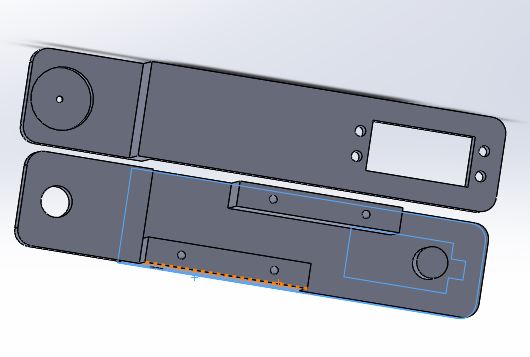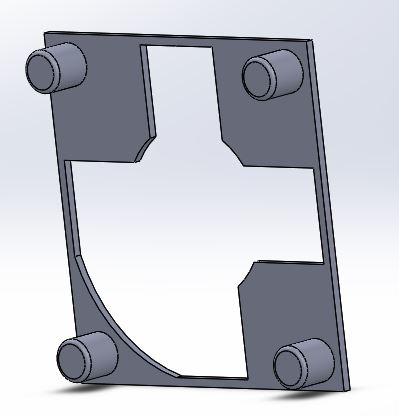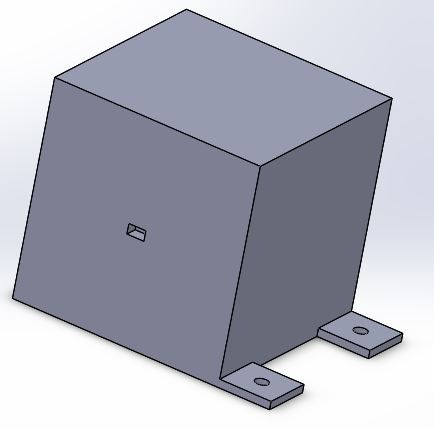Limbi/Spring /19
Limbi: Mechanical Design Iteration
Author/s: Ridel A. Samonte, PM and D&M
Table of Contents
Introduction
There are three main mechanical assembly for Limbi: Arm, Docking mechanism, and the module. Rapid prototyping lead to several critical design changes. The following are the main design changes made:
(Note: all images provided are the final design iteration)
Arm Design
The Limbi Arm is comprise of 5 Limbs: L0, L1, L2, L3, L4. This 400D Limbi version is a scaled down (1/2) version of JPL’s Limbi. The dimensions are taken directly from JPL’s LIMBI IEEE paper. The design however is a product of functionality and simplicity.
Each limb has two layers (top and bottom) to hold the servos in place, a brace on each side to put the two layers together as a limb and servo mount holes/cuts/grooves. Limb 1, Limb 2 and Limb 3 bottom layer has swivels to act as joint 1, 2, 3 and 4.
There are 10 main design iteration for the arm design:
- Press fit extrusion and hole pairs for the brace and limb layers to reduce amount of screws and for easier assembly.
- Tolerances and placements for the servo/ joints/ adjacent limbs mounts holes/grooves/cuts/extrusions for snug fits, cosmetics and even arm design.
- Space for the electronics in the middle of limb 2 (extruded rectangle in the middle).
- Extrusion in the bottom layer of L1 and L3 for an even ball caster height and easier installation (vs long threaded screw to adjust height previously).
- Incorporation of swivels (joints) in the bottom layer of L2, L1 and L3 to have it as one whole piece (vs a different component previously)
- Removal of Circular stands with extruded domes (for small contact points) from L1 and L3 (replaced with ball casters instead).
- Two smaller casters in L1 and L3 (four total) to keep the arm standing for every possible position (vs 1 big one for each causing the limb to roll in a very unstable fashion).
- Lengths of the Limbs:
- L0, L1, L3, L4: easier inverse kinematics (ratio for the lengths of L0 and L1 is a critical part of inverse kinematics).
- L2: limited range of actuators used (servos) caused a problem performing phase 2 of mission objective.
- Added hooks on the inside of the brackets for cable routing.
- Lengths of braces to cover inside as much as possible while accommodating the range of motion for joints 1, 2, 3, 4.
Notes:
- The length of the limbs are not measured from tip to tip of the mechanical assembly but rather the distance between two adjacent servo gears (joint to joint).
- It is later discovered that the limited range of the actuators used (servos) caused problems with arm motion therefore requirement is later change to form factor of JPL’s Limbi (see iteration #8).
L2
L1 and L3
L0 and L4
Braces
Docking Design
The Docking Mechanism is the main design innovation of Limbi.
There are two main design challenge for the docking mechanism:
- Momentum less docking and undocking
- Power transfer interface
There are 10 main design iteration for the docking design:
- Placement of modular contacts (for the power transfer) in docking layer 1 (which itself had few iterations).
- Tolerances for the docking layer 2 (bigger slot).
- Press fit extrusion and hole pair for docking layer 1 and docking layer 2.
- Dimensions of the cross.
- Housing in one of the cross branch for the push-pull solenoid valve for the positive lock.
- Grooves/cuts in cross for conductive tip design (for power transfer) and cable routing.
- Servo Coupler integrated in the cross (vs a separate component previously).
- Higher walls for the docking layer 1 for smoother turn for the cross when engaging (cross will get caught during turn if tolerance is too tight).
- Tolerance for the holes for the Solenoid Valve autolock of docking layer 1.
- Snug fit Housing for the modular contacts of docking layer 1 and the cut where the wires run through.
Docking Layer 1
Docking Layer 2
Cross
Module Design
The module design is the simplest part of Limbi. Design is based on the final docking mechanism design (for the cable routing and fittings), permanent magnet placement for module-to-module design and the LiPo battery placement. Dimensions (4x4x4 inches) are 1/2 of JPL’s Limbi module (8x8x8 inches).
Three faces of the module have special features: One face to mount LiPo battery, another face to mount permanent magnets for module-to-module connection and one open face for the docking layer for arm-to-module connection.
There are 4 main design iteration for the module design:
- Magnet placement hiding the magnets behind the walls so outside faces are flat (vs expose permanent magnets previously).
- Housing for the LiPo Battery.
- Cut for the charging port for the battery.
- Bracket at the opposite side of the arm-to-module face to secure position of module 1 as part of the requirement.
Conclusion
Rapid Prototyping helped Limbi team tremendously. We are able to see design flaws early in the design process.
The reason why we are able to rapid prototype this much is because I have my own printer. We are able to print ideas, fix design flaws and test fittings anytime we want without the worry of paying for a costly 3D print service.
Side note: I personally recommend buying your own 3D printer. It is a great investment. I recommend Creality Ender-3 as a starting point (Banggood usually has the cheapest deal for this printer).
















